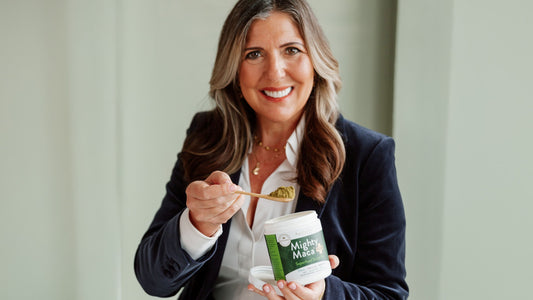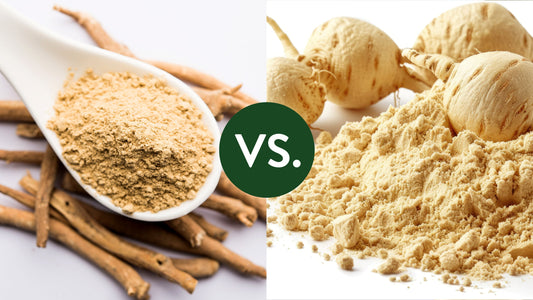While estrogen and progesterone often take center stage in discussions about menopause, we can’t forget about the big T — testosterone. While you might think of testosterone as a “male” hormone, it does play a vital role in your hormonal landscape, especially as balance starts to shift in perimenopause and menopause.
As you age, testosterone levels often naturally decline, leading to changes in muscle mass, energy levels, mood, and sexual health.
Testosterone levels can also go high in menopause, leading to acne, hair loss on your head, and hair growth on your chin.
For some women, testosterone therapy can be a potential solution to ease menopausal symptoms, but it also comes with important considerations and risks.
In this article, you will learn:
- How testosterone levels naturally change as you age
- Why testosterone is important for your body
- How to tell if you have too much or too little testosterone
- The benefits and risks of testosterone therapy during menopause
- How lifestyle factors, like vitamin D levels, could also influence testosterone levels
Ready? Let’s explore how testosterone impacts women during menopause.


Testosterone is often labeled as a "male hormone," but it plays an essential role in women’s health as well. It’s believed that women actually produce as much as three times more testosterone than estrogen before menopause. (1)
Produced primarily by the ovaries (and a little bit by the adrenal glands), testosterone contributes to energy levels, muscle strength, mood regulation, and sexual health. (2) Although women naturally have lower testosterone levels than men, this hormone is still vital for maintaining our physical and emotional well-being.
How Testosterone Levels Change with Age
In women without hormone imbalances like polycystic ovarian syndrome (PCOS), peak testosterone production occurs in their 20s. After that, levels begin to decline gradually over time.
By the time a woman enters menopause, testosterone levels can be significantly lower due to several factors:
The natural aging process. When ovarian function slows down, fewer sex hormones are produced, including testosterone.
Perimenopause and menopause. The transition into menopause intensifies hormonal fluctuations, causing a more noticeable drop in testosterone.
Surgical menopause. Women who undergo a hysterectomy that includes oophorectomy (removal of ovaries) will experience a sharp decline in testosterone production.
By the postmenopausal stage, women may have testosterone levels that are half or even lower than what they had in their younger years.
This reduction can contribute to symptoms such as (3):
Fatigue
Muscle weakness
Mood changes
Reduced libido (this is one of the biggest tells and one of the things most women complain about)
The Role Of Testosterone In Women’s Health
Though often overshadowed by estrogen and progesterone, testosterone is a key player in women’s overall health. It influences several key functions that support physical strength, mental well-being, and sexual health.
Here are a few of the reasons it’s so important. (4)


Testosterone is crucial for building and maintaining lean muscle mass.
This is especially important for women during and after menopause when muscle loss accelerates.
Testosterone plays a role in:
Muscle preservation. Adequate testosterone helps prevent age-related muscle wasting (sarcopenia). This is SO important as you age. Muscle mass helps support insulin sensitivity, and is critical for mobility, bone health, and independence.
Metabolism. More muscle mass also leads to a higher resting metabolism, making it easier to manage weight.
Fall and injury prevention. Stronger muscles improve balance and coordination, reducing the risk of falls and fractures — which can be a significant concern as you age. Protecting your muscles NOW means strength later!


While estrogen is often highlighted for bone health, testosterone also plays a supporting role in maintaining bone density. Low testosterone levels can contribute to bone thinning, increasing the risk of osteoporosis and fractures.


Testosterone influences neurotransmitters in the brain, impacting mood, mental clarity, and emotional stability.
It helps contribute to:
Mood stability — Low testosterone levels can contribute to mood swings, irritability, and even depression.
Mental sharpness — Balanced testosterone supports cognitive functions such as memory, focus, and problem-solving.
Energy and motivation — Many women report feeling more energetic and motivated when testosterone levels are optimized.


One of the most noticeable effects of declining testosterone in women is a reduced sex drive.
And that’s because testosterone plays a direct role in sexual arousal and satisfaction.
Adequate testosterone levels contribute to a healthy sex drive.
Testosterone can also improve sexual sensitivity and satisfaction.
Balanced testosterone may help with vaginal tissue health, which reduces discomfort during intercourse.
Does Testosterone Increase During Menopause?
While low testosterone is more common in menopausal women, some women experience elevated testosterone levels, which can disrupt hormonal balance and cause a range of symptoms. (5)
Ideally, your sex hormones balance each other out — and when one gets off kilter, another usually rises up to fill the void. In menopause, testosterone can often do this, elevating without its natural foils estrogen and progesterone to keep it in check.
This can lead to breakouts, hair loss (on your head), and hair growth (on your chin). Not fun.
Causes Of High Testosterone in Women
There are also several health conditions and lifestyle factors that could contribute to increased testosterone levels in women:
Polycystic Ovary Syndrome (PCOS)
A hormonal disorder that affects how the ovaries function, leading to elevated testosterone. PCOS is one of the most common causes of high testosterone in women.
Adrenal Gland Disorders
The adrenal glands produce small amounts of testosterone. Disorders like congenital adrenal hyperplasia can cause overproduction.
Tumors
Sometimes ovarian or adrenal tumors can secrete excess testosterone.
Medications
Certain medications, such as anabolic steroids or hormone therapies, can increase testosterone levels.
Insulin Resistance
Conditions like Type 2 diabetes or obesity can lead to higher insulin levels, which may stimulate increased testosterone production.
Symptoms Of High Testosterone in Women
Elevated testosterone can lead to both physical and emotional symptoms, which vary in severity.
Here are some of the common signs your testosterone may be out of balance.















Potential Health Risks Of High Testosterone
If left unmanaged, high testosterone can lead to additional health complications like:
Infertility: Irregular ovulation caused by hormonal imbalance can make it difficult to conceive.
Metabolic issues: Elevated testosterone is linked to insulin resistance, increasing the risk of Type 2 diabetes and metabolic syndrome.
Cardiovascular risks: Hormonal imbalances can contribute to higher cholesterol levels and increased heart disease risk.
Low Testosterone In Women
Low testosterone levels are far more common in women, especially during and after menopause. Since testosterone contributes to energy, muscle mass, mood, and sexual health, its decline can significantly impact overall well-being.
Causes Of Low Testosterone In Women
Several factors can contribute to low testosterone levels in women, particularly as you age:
Natural Aging And Menopause
As we’ve discussed, this is the number one cause of low testosterone in women. As your ovaries prepare to end their baby-making era, they produce fewer hormones, including testosterone.
Ovarian Removal (Oophorectomy)
Surgical removal of the ovaries results in an abrupt decline in testosterone and other sex hormones.
Adrenal Dysfunction
The adrenal glands produce small amounts of testosterone, so adrenal fatigue or disorders can lower levels.
Birth Control Pills
Long-term use of hormonal contraceptives can suppress natural testosterone production.
Chronic Illness Or Stress
Conditions like hypothyroidism, chronic fatigue syndrome, or high stress can disrupt hormonal balance.
Certain Medications
Corticosteroids and some antidepressants can lower testosterone levels over time.
Symptoms Of Low Testosterone In Women
Low testosterone can manifest through subtle or significant symptoms that affect physical, emotional, and sexual health:
Persistent fatigue: Constant tiredness and lack of energy, even after adequate rest.
Decreased muscle mass and strength: Difficulty maintaining or building muscle, leading to overall weakness.
Weight gain: Slower metabolism and muscle loss contribute to increased body fat, particularly around the abdomen.
Low libido: A significant drop in sexual desire and reduced sexual satisfaction.
Mood changes: Depression, anxiety, mood swings, and feelings of irritability.
Poor concentration and memory: Difficulty focusing, brain fog, and memory lapses.
Bone weakness: Increased risk of osteoporosis and fractures due to reduced bone density.
Sleep disturbances: Trouble falling or staying asleep, often linked with fatigue and mood issues.
Potential Health Risks Of Low Testosterone
Chronic low testosterone levels can increase the risk of several health conditions:
Osteoporosis: Weakening bones and increased fracture risk due to decreased bone density.
Muscle Wasting (Sarcopenia): Accelerated muscle loss, leading to frailty and reduced mobility.
Metabolic Disorders: Higher susceptibility to insulin resistance, weight gain, and type 2 diabetes.
Cardiovascular Concerns: Emerging research suggests low testosterone may contribute to heart health issues.
Testosterone Therapy For Menopause: Pros And Cons
For women struggling with the symptoms of low testosterone during menopause, testosterone therapy may offer relief and help restore hormonal balance.
While traditionally used to treat men with low testosterone, this therapy is gaining attention as a treatment option for women experiencing fatigue, low libido, mood changes, and muscle loss.
However, like any medical treatment, it comes with both benefits and risks that must be carefully considered.


There are several methods of administering testosterone therapy, each with its own advantages and drawbacks:
Topical Creams and Gels: Applied directly to the skin for daily absorption. Easy to adjust dosage but may transfer to others through skin contact.
Injections: Administered intramuscularly, typically every 1–2 weeks. Offers consistent dosing but may cause hormone level fluctuations.
Transdermal Patches: Provide a steady release of testosterone but can irritate the skin.
Pellet Implants: Small pellets inserted under the skin (usually in the hip area) that release testosterone gradually over 3-6 months.
Pellet therapy is becoming increasingly popular for women due to its convenience and long-lasting effects, but keep in mind this is a surgical procedure where a pellet is implanted into your subcutaneous tissue (fat) beneath the skin in the buttocks or upper outer thigh. This can be painful, and even cause bruising or infections, so they aren’t completely without risk.
Oral Tablets (Less Common): Rarely used due to potential liver strain and less predictable hormone absorption.
However, it's important to note that testosterone therapies for women should be closely supervised by a healthcare provider.
Benefits Of Testosterone Therapy For Menopause
For women with low testosterone, replacement therapy could be beneficial.
Here are some of the things women often see improve when they get their testosterone dialed in:
 Improved libido and sexual function
Improved libido and sexual function
 Increased energy and reduced fatigue
Increased energy and reduced fatigue
 Enhanced muscle mass and strength
Enhanced muscle mass and strength
 Better mood and emotional stability
Better mood and emotional stability
 Stronger bones
Stronger bones
Side Effects And Risks Of Testosterone Therapy For Women
Testosterone therapy isn’t necessarily all rainbows and butterflies, though.
Here are some of the side effects of testosterone therapy that women complain about after getting on supplemental testosterone:
 Acne
Acne
 Oily Skin
Oily Skin
 Irritability
Irritability
 Aggression
Aggression
 Mood Swings
Mood Swings
 Voice Changes
Voice Changes
 Clitoral enlargement
Clitoral enlargement
 Unwanted facial or body hair growth (hirsutism)
Unwanted facial or body hair growth (hirsutism)
 Potential cardiovascular risks (Long-term safety data is limited, and excessive testosterone could increase the risk of heart disease)
Potential cardiovascular risks (Long-term safety data is limited, and excessive testosterone could increase the risk of heart disease)
It’s important to point out that testosterone pellet therapy isn’t without risk. Although convenient, pellets cannot be adjusted once implanted, which makes it harder to get the dosing just right. They may also cause infection or implant site discomfort.
✔ Improved libido and sexual function
✔ Increased energy and reduced fatigue
✔ Enhanced muscle mass and strength
✔ Better mood and emotional stability
✔ Stronger bones
Side Effects And Risks Of Testosterone Therapy For Women
Testosterone therapy isn’t necessarily all rainbows and butterflies, though.
Here are some of the side effects of testosterone therapy that women complain about after getting on supplemental testosterone:
✔ Acne
✔ Oily Skin
✔ Irritability
✔ Aggression
✔ Mood Swings
✔ Voice Changes
✔ Clitoral enlargement
✔ Unwanted facial or body hair growth (hirsutism)
✔ Potential cardiovascular risks (Long-term safety data is limited, and excessive testosterone could increase the risk of heart disease)
It’s important to point out that testosterone pellet therapy isn’t without risk. Although convenient, pellets cannot be adjusted once implanted, which makes it harder to get the dosing just right. They may also cause infection or implant site discomfort.
Medical Considerations And FDA Guidance
Currently, testosterone therapy for women is not FDA-approved. (6) Physicians often prescribe it in an "off-label" manner. You cannot get testosterone therapy over the counter.
If you do decide to try out testosterone, regular testing is necessary to ensure safe and effective dosing. And it’s important to make sure your therapy and dosing is personalized to you. Everyone’s body is different, and hormone levels vary widely.
While testosterone therapy can provide significant benefits for some women, it’s not a one-size-fits-all solution. Careful consideration of the pros and cons, along with close medical supervision, is crucial.
Does Vitamin D Increase Testosterone In Females?
Vitamin D, often referred to as the "sunshine vitamin," is well-known for supporting bone health and immune function.
However, emerging research suggests that vitamin D may also play a role in hormonal balance, including the regulation of testosterone levels in women. (7)
The Connection Between Vitamin D And Hormone Production
Vitamin D functions more like a hormone than a traditional vitamin because it interacts with hormone receptors throughout the body. It influences various biological processes, including the production of sex hormones such as testosterone.
You have vitamin D receptors in the ovaries and the adrenal glands. Your adrenals are responsible for producing small amounts of testosterone in women. So, adequate vitamin D levels may support the optimal functioning of these glands.
Several studies have explored how vitamin D levels might influence testosterone production:
Some research has shown a positive correlation between vitamin D levels and testosterone in women. (8)
One recent study showed that women with sexual dysfunction had low vitamin D levels, and supplementation appeared to improve testosterone levels, oxidative stress markers, and sexual function. (9)
What’s really interesting is that women with PCOS often have both low vitamin D and high testosterone. And vitamin D supplementation in these women appears to decrease testosterone levels and improve insulin sensitivity. (10)
So, maintaining healthy vitamin D levels could indirectly support hormone balance and testosterone levels (whether too high OR too low), especially in women with deficiencies.
How To Maintain Healthy Vitamin D Levels
Ensuring adequate vitamin D levels can be a simple yet effective way to support overall hormonal health. It’s important to note that you should always aim for a balance between D3 and K2 . I discuss this in detail in this article.
Here’s a quick rundown of ways to maintain optimal vitamin D levels:
- Sunlight Exposure: Spending 10–30 minutes in sunlight a few times a week helps the body produce vitamin D naturally.
- Dietary Sources: Include vitamin D-rich foods like fatty fish (salmon, mackerel), fortified dairy products, egg yolks, and mushrooms.
- Supplements: Vitamin D3/K2 supplements can help, especially during winter or for those with limited sun exposure. Consult with a healthcare provider for proper dosing.
- Regular Testing: Routine blood tests can help monitor vitamin D levels. Your doctor may not be inclined to offer this automatically — be sure to ask for it, though, as it is very helpful to know your levels so you can supplement effectively.
Although vitamin D alone may not drastically increase testosterone levels, maintaining adequate levels is a foundational step in supporting overall hormonal health, energy, and well-being during menopause.
5 Natural Ways to Support Healthy Testosterone Levels
For women seeking to manage low testosterone symptoms during menopause, lifestyle and dietary changes can make a big difference.
While testosterone therapy is an option, I always like to explore holistic approaches first.
Incorporating just a few of these natural strategies can help you feel like a new woman.
Physical activity, especially strength training, is one of the most effective natural ways to support testosterone production.
The best workout is one that incorporates a rotation of both resistance training and cardio. Try to get as much exercise as possible (at least 3–4 times per week).
In addition to hormone balance, strength training also combats muscle loss and boosts metabolism, both of which naturally decline during menopause, so resistance training is a must.


A healthy diet always plays a vital role in hormone production and balance.
And certain nutrients are directly linked to healthy hormones, so be sure to load up on:
Healthy fats: Incorporate sources of omega-3 and monounsaturated fats, such as avocado, olive oil, nuts, and fatty fish.
Protein: Adequate protein intake supports muscle repair and hormone production. Meats, eggs, and plant-based options like my Keto-Green Shake are great choices.
Zinc and magnesium: These minerals are essential for hormone production. Foods rich in zinc (pumpkin seeds, shellfish) and magnesium (leafy greens, nuts) can help.
As always, it’s a good idea to reduce excess sugar and refined carbs. These foods can increase insulin resistance, which may impact testosterone levels.


Chronic stress triggers the release of cortisol, a stress hormone that can suppress testosterone production when elevated over long periods.
While it’s easier said than done, it’s important to get stress under control. Too much cortisol wreaks havoc on your hormones and your health.
If you haven’t explored some mindfulness practices or meditation (it’s not as hard as it sounds!) it’s never too late to start.
Also, moving your body lowers cortisol, and helps everything else, too. So yes, here’s another reason to EXERCISE!
Scheduled, relaxing downtime and self-care practices also can help to reduce stress and promote hormonal balance. Don’t skimp on your me-time.


Your body can’t mount a measured stress response if you don’t get plenty of rest. So be sure to work in plenty of sleep to your routine. 7-9 hours of sleep is ideal.
Sleep is when the body repairs and regulates hormone production, so it really is that important.
I go into all of the ways to create a perfect sleeping environment in this article, but here’s the gist: keep the bedroom dark, quiet, and cool to support deeper sleep cycles. And reduce blue light exposure before bed to encourage natural melatonin production.


Excess body fat, particularly around the abdomen, could disrupt hormonal balance and lower testosterone levels.
When you’re embarking on a weight loss journey, be sure to focus on fat loss, not just weight loss for best results. Preserving muscle mass while reducing fat is critical for hormonal health.
Testosterone For Menopause: Final Thoughts
Testosterone plays a far more significant role in women’s health than you may realize, especially during menopause. As testosterone levels naturally decline with age, it can cause a variety of symptoms, from fatigue and muscle loss to mood changes and reduced libido.
While testosterone therapy may offer relief for some women, it’s essential to weigh its benefits and potential side effects carefully and pursue treatment under medical supervision. At the same time, adopting natural strategies like strength training, balanced nutrition, and stress management can always complement hormone therapy or serve as a holistic approach to hormonal health.
For an easy and effective way to boost libido, I personally prefer vaginal DHEA to testosterone. DHEA gives your body what it needs to make other hormones, including testosterone. Learn more about my signature Julva cream here.









